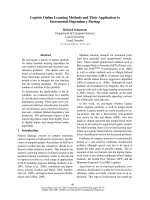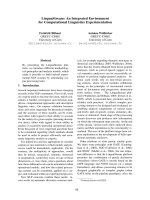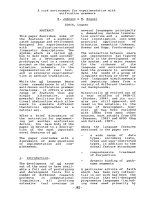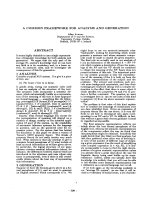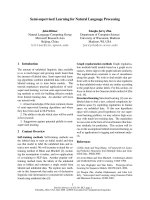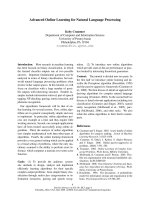Báo cáo khoa học: "Advanced Online Learning for Natural Language Processing" pot
Bạn đang xem bản rút gọn của tài liệu. Xem và tải ngay bản đầy đủ của tài liệu tại đây (65.91 KB, 1 trang )
Tutorial Abstracts of ACL-08: HLT, page 4,
Columbus, Ohio, USA, June 2008.
c
2008 Association for Computational Linguistics
Advanced Online Learning for Natural Language Processing
Koby Crammer
Department of Computer and Information Science
University of Pennsylvania
Philadelphia, PA 19104
Introduction: Most research in machine learning
has been focused on binary classification, in which
the learned classifier outputs one of two possible
answers. Important fundamental questions can be
analyzed in terms of binary classification, but real-
world natural language processing problems often
involve richer output spaces. In this tutorial, we will
focus on classifiers with a large number of possi-
ble outputs with interesting structure. Notable ex-
amples include information retrieval, part-of-speech
tagging, NP chucking, parsing, entity extraction, and
phoneme recognition.
Our algorithmic framework will be that of on-
line learning, for several reasons. First, online algo-
rithms are in general conceptually simple and easy
to implement. In particular, online algorithms pro-
cess one example at a time and thus require little
working memory. Second, our example applications
have all been treated successfully using online al-
gorithms. Third, the analysis of online algorithms
uses simpler mathematical tools than other types of
algorithms. Fourth, the online learning framework
provides a very general setting which can be applied
to a broad setting of problems, where the only ma-
chinery assumed is the ability to perform exact in-
ference, which computes a maxima over some score
function.
Goals: (1) To provide the audience system-
atic methods to design, analyze and implement
efficiently learning algorithms for their specific
complex-output problems: from simple binary clas-
sification through multi-class categorization to in-
formation extraction, parsing and speech recog-
nition. (2) To introduce new online algorithms
which provide state-of-the-art performance in prac-
tice backed by interesting theoretical guarantees.
Content: The tutorial is divided into two parts. In
the first half we introduce online learning and de-
scribe the Perceptron algorithm (Rosenblatt, 1958)
and the passive-aggressive framework (Crammer et
al., 2006). We then discuss in detail an approach for
deriving algorithms for complex natural language
processing (Crammer, 2004). In the second half we
discuss is detail relevant applications including text
classification (Crammer and Singer, 2003), named
entity recognition (McDonald et al., 2005), pars-
ing (McDonald, 2006), and other tasks. We also
relate the online algorithms to their batch counter-
parts.
References
K. Crammer and Y. Singer. 2003. A new family of online
algorithms for category ranking. Jornal of Machine
Learning Research, 3:1025–1058.
K. Crammer, O. Dekel, J. Keshet, S. Shalev-Shwartz,
and Y. Singer. 2006. Online passive-aggressive al-
gorithms. JMLR, 7:551–585.
K. Crammer. 2004. Online Learning of Complex Cate-
gorial Problems. Ph.D. thesis, Hebrew Universtiy.
R. McDonald, K. Crammer, and F. Pereira. 2005. Flex-
ible text segmentation with structured multilabel clas-
sification. In HLT/EMNLP.
R. McDonald. 2006. Discriminative Training and Span-
ning Tree Algorithms for Dependency Parsing. Ph.D.
thesis, University of Pennsylvania.
F. Rosenblatt. 1958. The perceptron: A probabilistic
model for information storage and organization in the
brain. Psychological Review, 65:386–407.
4
